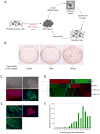A high-efficiency system for the generation and study of human induced pluripotent stem cells
- PMID: 18786420
- PMCID: PMC3987901
- DOI: 10.1016/j.stem.2008.08.003
A high-efficiency system for the generation and study of human induced pluripotent stem cells
Abstract
Direct reprogramming of human fibroblasts to a pluripotent state has been achieved through ectopic expression of the transcription factors OCT4, SOX2, and either cMYC and KLF4 or NANOG and LIN28. Little is known, however, about the mechanisms by which reprogramming occurs, which is in part limited by the low efficiency of conversion. To this end, we sought to create a doxycycline-inducible lentiviral system to convert primary human fibroblasts and keratinocytes into human induced pluripotent stem cells (hiPSCs). hiPSCs generated with this system were molecularly and functionally similar to human embryonic stem cells (hESCs), demonstrated by gene expression profiles, DNA methylation status, and differentiation potential. While expression of the viral transgenes was required for several weeks in fibroblasts, we found that 10 days was sufficient for the reprogramming of keratinocytes. Using our inducible system, we developed a strategy to induce hiPSC formation at high frequency. Upon addition of doxycycline to hiPSC-derived differentiated cells, we obtained "secondary" hiPSCs at a frequency at least 100-fold greater than the initial conversion. The ability to reprogram cells at high efficiency provides a unique platform to dissect the underlying molecular and biochemical processes that accompany nuclear reprogramming.
Figures


References
-
- Kopp JL, Ormsbee BD, Desler M, Rizzino A. Small increases in the level of sox2 trigger the differentiation of mouse embryonic stem cells. Stem Cells. 2008;26:903–911. - PubMed
Publication types
MeSH terms
Grants and funding
LinkOut - more resources
Full Text Sources
Other Literature Sources
Medical
Molecular Biology Databases
Research Materials

